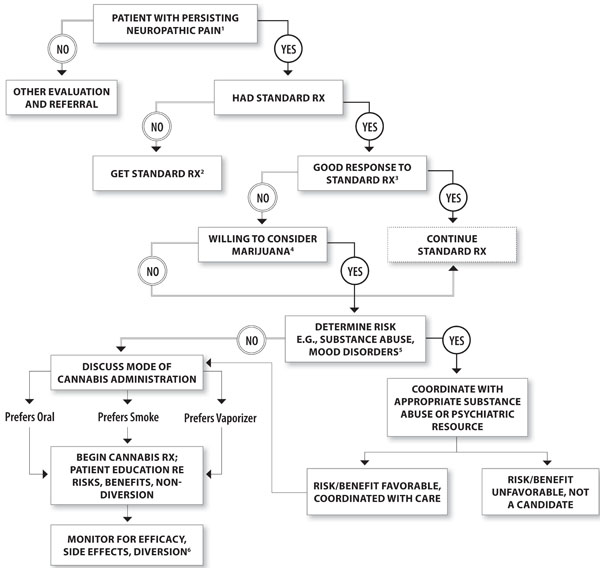Fig. (1) A decision tree approach for physicians who may be considering recommending medicinal cannabis to a patient. This decision tree suggests some key points that a physician may need to consider in making his/her determination. In this case, a patient is assumed to present with persistent neuropathic pain. Initially, a determination needs to be made that the patient’s signs and symptoms are indeed consistent with this diagnosis. Assuming a patient does not respond favorably to more standard treatments (e.g., antidepressants, anticonvulsants, etc), or cannot tolerate those, and the patient is willing to consider medicinal cannabis, the physician needs to determine risk versus benefit. Among these considerations is whether there is a history of substance abuse or serious psychiatric disorder that might be exacerbated by medicinal cannabis. Even if such risks exists, this does not necessarily preclude the use of medicinal cannabis; rather coordination with appropriate substance abuse and psychiatric resources is necessary, and based on such consultation a risk benefit ratio can be determined. In patients in whom the ratio appears favorable, the physician needs to discuss alternative modes of cannabis administration which may include oral, smoked, or vaporized systems. Once risks and benefits are evaluated and discussed with the patient, cannabis treatment may commence as with other psychotropic medications, with attention being paid to side effects as well as efficacy. In addition, there needs to be attentiveness to potential for misuse and diversion, which can then trigger a decision to discontinue.KeyDaily or almost daily pain with typical neuropathic characteristics for at least 3 months; affects life quality.Standard Rx = e.g., antidepressants, anticonvulsants; opioids; nonsteroidal anti-inflammatory drugs.For example, at least 30% reduction in pain intensity.Consider past experience, possible past history of side effects; willingness to smoke.Determine history of substance abuse. If yes, or at “high risk” aberrant for drug behavior; proceed with close observation; possibly coor-dinate with substance abuse treatment program.Efficacy = at least 30% reduction in pain intensity.


